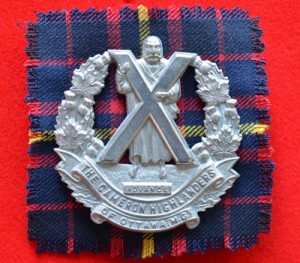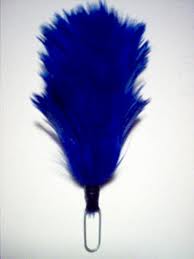Cap badge and Hackle
The Regimental Badge or crest is laid out as follows: within a wreath of thistles and maple leaves, the figure of St Andrew with cross is shown standing on a mount charged with a plaque inscribed ADVANCE. On the lower bend of the wreath there are two rolls, the upper inscribed THE CAMERON HIGHLANDERS, the lower OF OTTAWA (M.G.).
In 1939 the War Office ordered that the service dress of the highland regiments would be the universal battle dress. In effect the kilt was abolished as the uniform of a highland soldier in battle. This caused much resentment amongst highland regiments. On 5 Dec 1939, HM King George Vl visited the British Expeditionary Forces in the field. The Camerons were paraded in kilted order for their Colonel in Chief, who was notably impressed. The CO at the time suggested that if the regiment was not allowed to wear the kilt, it should be at least allowed to wear a hackle behind the badge in the Balmoral. The King agreed to this idea and also to the suggestion that Royal Blue would be an appropriate colour. The blue hackle was first worn at Arras in Feb 1940. While the exact date the Cameron Highlanders of Ottawa started wearing the blue hackle is unclear, the Regiment returned from World War ll wearing them.
The cap badge, tartan patch and balmoral are presented to each recruit upon successful completion of the Basic Infantry Qualification (BIQ or DP1) course. This signifies completion of the basic knowledge and skills and welcomes the member into the Cameron Clan.



